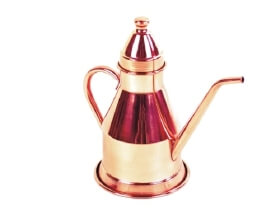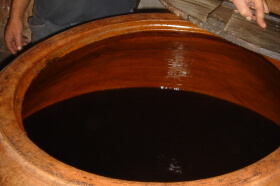

Olive oil is so essential to Italian cooking, pizza and focaccia that we often joke that it comprises its own food group. We were told, somewhat seriously, by the lady who manages the San Gimignano Comunale Frantoio (city owned olive mill) that they know of local families who consume over 80 liters of olive oil per year. In fact, the per capita consumption of olive oil in Italy is a high 13.5 liters per year, compared with only .6 liters per person in the U.S. As a side note, the per capita consumption in Greece is a remarkable 30 liters.
To see how Extra Virgin Olive Oil is made the old-fashioned way, check out our Olive Oil Production Photo Journal.
While the health benefits of olive oil can be debated, the wonderful flavors cannot, and we think of it as our responsibility to help change America’s consumption pattern. U.S. olive oil consumption doubled in the 1990s, and all signs are that American usage is continuing to go up.
We use two types of olive oil—both extra virgin (EVOO). A cooking olive oil, a mass produced extra virgin olive oil for cooking under heat (which takes away most of the flavor), and an eating olive oil, a specialty extra virgin olive oil for salad, and topping pizza, focaccia, soups and grilled meats. Always use your best olive oil for pizza — you will taste the difference. We don’t have any other oil in the house.
The most famous Italian olive variety is the Frantoio (not to be confused with the olive oil press of the same name), and there are many 100% Frantoio oils available in the U.S. Recently, there has been a mini-scandal in Italy about non-Italian Italian olive oil, so take care to make sure you taste the oil you buy, and make sure you like it before you buy more.
Our experience is that you can get an excellent specialty oil without spending an arm and a leg. Personally, we don’t think that the shape of the bottle or the cork has a big impact on flavor, or that a small bottle of olive oil should cost more than a nice dinner out.
Oil First or Last
We have seen olive oil added to a thrown pizza base before the sauce and ingredients are added, and we have seen olive oil drizzled off the pizza at the end after it has been fully assembled. The Vera Pizza Napoletana specification calls for olive oil on top. Still, when you are using such great ingredients as fresh dough, fresh mozzarella, and specialty olive oil, your pizza will be great either way — see what works for you.
Pour Don’t Brush
Regardless of when you add you oil, we would recommend using a Metal Oil Canister or wine bottle with a spout rather than a brush. We think that making pizza should be more of a contact sport than a fussy cooking experience and that speed matters. With pizzas flying through your oven every three minutes — often two or three at a time, it is fun and practical to get good at making pizzas quickly.
Pour your oil on in a circular pattern, and if you want to cover the dough for a flatbread or to seal a pizza, use the back of the spoon or ladle your are using for your tomato sauce to smooth it out.




